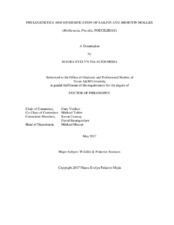| dc.description.abstract | Phylogeography aims to understand the formation of species across space and time. Freshwater fishes are studied because they strongly reflect historical and ecological changes in a region. The objective of this dissertation is to identify historic geological events and ecological factors that shaped the evolution of species in the subgenus Mollienesia (Poecilia, Mollienesia, Poeciilidae) within the geologically dynamic regions of Mexico, Central America, and the Caribbean. I investigate the evolutionary relationships in 19 of the 25 species by conducting phylogenetic, species trees with molecular clock estimates, and ancestral area estimates analyses on a multi-locus dataset. The phylogenetic and species trees results support three main groups: Poeciia latipinna, P. sphenops, and P. mexicana species complexes. The molecular clock estimates are inconclusive and ancestral area estimates indicate the diversity originated from the Maya and Chortis blocks. These findings uncover allopatric and ecological speciation events in the three main regions. I also analyze a threegene dataset of fine scale sampling in Mexico of the P. sphenops and P. mexicana species complexes under phylogenetic and haplotype network. The phylogenetic results show that Mexican species are a result of independent invasions from Middle America with subsequent diversification. Haplotype network analyses demonstrate that within species, physiographic barriers or river basins cause strong phylogeographic structure of some species, while others show only weak structuring. These patterns are shared with other Neotropical freshwater fishes, mammals, amphibians, and birds. Lastly, I report on the phylogenetic, population genetics, and geometric morphometrics assessment of the sulfide spring rediscovered species Poecilia thermalis from Mexico, after 150 years of the type locality being unknown to science. Phylogenetic analysis finds P. thermalis to be sister to one population of P. sulphuraria and not an independent lineage, complicating the systematics. Population genetic analyses shows P. thermalis to be genetically distinct from adjacent species found in freshwater and shape analyses finds unique morphological characteristics like an enlarged head and wide mouth to aid in the uptake of oxygen, a limited resource in an extreme habitat. This dissertation identified mechanisms of speciation in the subgenus Mollienesia and contributed a wealth of genetic information from previously unsampled regions. | en |


